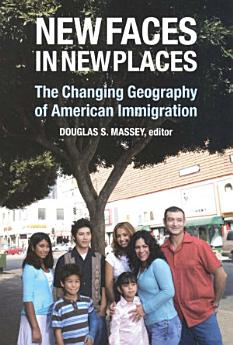New Faces in New Places: The Changing Geography of American Immigration
Douglas S. Massey
Feb 2008 · Russell Sage Foundation
Ebook
384
Pages
reportRatings and reviews aren’t verified Learn More
About this ebook
Beginning in the 1990s, immigrants to the United States increasingly bypassed traditional gateway cites such as Los Angeles and New York to settle in smaller towns and cities throughout the nation. With immigrant communities popping up in so many new places, questions about ethnic diversity and immigrant assimilation confront more and more Americans. New Faces in New Places, edited by distinguished sociologist Douglas Massey, explores today's geography of immigration and examines the ways in which native-born Americans are dealing with their new neighbors. Using the latest census data and other population surveys, New Faces in New Places examines the causes and consequences of the shift toward new immigrant destinations. Contributors Mark Leach and Frank Bean examine the growing demand for low-wage labor and lower housing costs that have attracted many immigrants to move beyond the larger cities. Katharine Donato, Charles Tolbert, Alfred Nucci, and Yukio Kawano report that the majority of Mexican immigrants are no longer single male workers but entire families, who are settling in small towns and creating a surge among some rural populations long in decline. Katherine Fennelly shows how opinions about the growing immigrant population in a small Minnesota town are divided along socioeconomic lines among the local inhabitants. The town's leadership and professional elites focus on immigrant contributions to the economic development and the diversification of the community, while working class residents fear new immigrants will bring crime and an increased tax burden to their communities. Helen Marrow reports that many African Americans in the rural south object to Hispanic immigrants benefiting from affirmative action even though they have just arrived in the United States and never experienced historical discrimination. As Douglas Massey argues in his conclusion, many of the towns profiled in this volume are not equipped with the social and economic institutions to help assimilate new immigrants that are available in the traditional immigrant gateways of New York, Los Angeles, and Chicago. And the continual replenishment of the flow of immigrants may adversely affect the nation's perception of how today's newcomers are assimilating relative to previous waves of immigrants. New Faces in New Places illustrates the many ways that communities across the nation are reacting to the arrival of immigrant newcomers, and suggests that patterns and processes of assimilation in the twenty-first century may be quite different from those of the past. Enriched by perspectives from sociology, anthropology, and geography New Faces in New Places is essential reading for scholars of immigration and all those interested in learning the facts about new faces in new places in America.
About the author
DOUGLAS S. MASSEY is Henry G. Bryant Professor of Sociology and Public Affairs at the Woodrow Wilson School.
Rate this ebook
Tell us what you think.
Reading information
Smartphones and tablets
Install the Google Play Books app for Android and iPad/iPhone. It syncs automatically with your account and allows you to read online or offline wherever you are.
Laptops and computers
You can listen to audiobooks purchased on Google Play using your computer's web browser.
eReaders and other devices
To read on e-ink devices like Kobo eReaders, you'll need to download a file and transfer it to your device. Follow the detailed Help Center instructions to transfer the files to supported eReaders.






